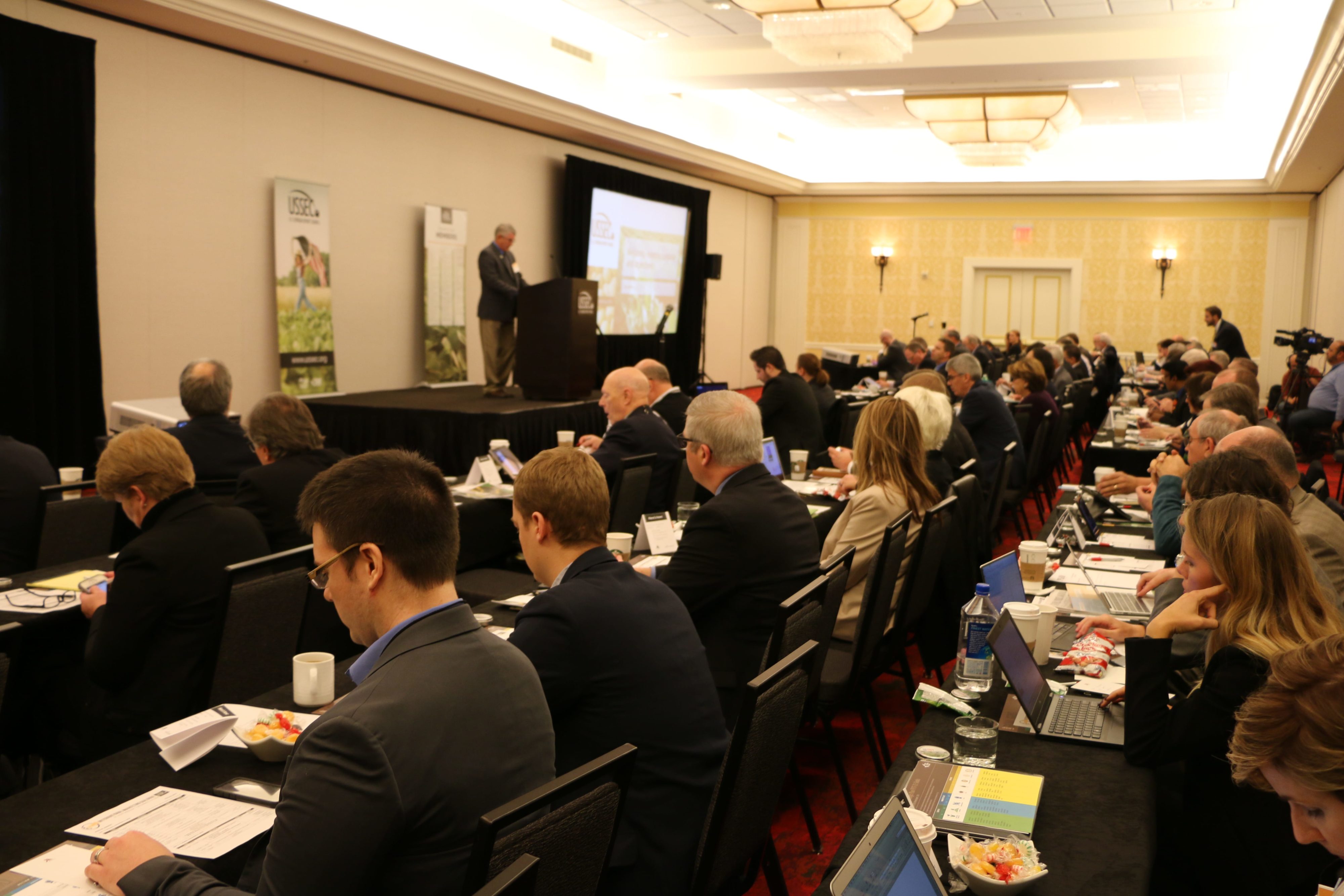USSEC Holds Inaugural International Marketing Dialogue
- Category:
- General News


USSEC held its first International Marketing Dialogue in St. Louis on December 5 and 6. Stakeholders of U.S. Soy, including USSEC members and grower leaders, attended the two-day event.
USSEC Chairman Jim Miller welcomed attendees.
“When we first started talking about putting this event together, we all agreed that our goal was to create a forum where our members can provide input and feedback on strategy and focus."
-Jim Miller, USSEC Chairman
The event aimed to do just that, as members heard from USSEC’s regional directors and various experts on the first day and attended a networking reception and dinner that evening. The second day was set up as an industry feedback forum with participants breaking into smaller teams focused on different utilization areas: market access; oil and human utilization; and animal and aquaculture feed utilization. The groups discussed what USSEC’s current activities, and industry and members provided USSEC with feedback and thoughts on the organization’s direction.
USSEC CEO Jim Sutter told the audience that U.S. soybeans are the country’s top agricultural export and stressed the importance of USSEC’s role of differentiating U.S. Soy and building market access.
United Soybean Board (USB) Chairman Jared Hagert spoke about the organization’s long range strategic plan (LRSP) and explained USB’s three target areas, meal, oil and sustainability, before moving into its action teams of supply, marketplace, and demand.
“It goes without saying that USB needs USSEC as a primary contractor. As the international marketing arm, USSEC plays an important role in meeting U.S. Soy’s goals.”
-Jared Hagert, USB Chairman
Foreign Agricultural Service (FAS) International Marketing Specialist Jarrod Jones gave details of the U.S. Department of Agriculture’s (USDA) strategic plan. USSEC receives funds from FAS through the American Soybean Association (ASA). USSEC’s Unified Export Strategy is USSEC’s application to FAS for FY18.
USSEC Chief Program Officer Ed Beaman spoke further on the topic of UES, explaining that UES is USSEC’s application for federal funds and described the organization’s strategic plans, which serve as a marketing plan for each target market/region.
Pro Exporter principal Marty Ruikka spoke on the topic of soy production and supply and demand and Tanner Ehmke, senior economist at CoBank talked about the macro and agricultural economic outlook.
That afternoon, participants heard an overview from each of the USSEC worldwide regions: North Asia, European Union (EU) / Middle East North Africa (MENA), Asia Subcontinent, Southeast Asia, and the Americas.
Stakeholders attended a reception and dinner that evening. Jim Wiesemeyer, senior vice president at Informa Economics, gave a presentation, “The New Administration and What This Means for U.S. Agriculture Trade.”
The conference reconvened the following morning with participants breaking into industry utilization groups.
In the market access group, key discussion items included biotech (regulatory and messaging); new breeding techniques; other regulatory challenges creating non-tariff barriers; and that tariff barriers are more limited.
Syngenta’s Ryan Findlay was elected chairman of the market utilization team. Lucas Blaustein of the Lansing Trade Group was elected vice chairman.
Mr. Findlay pointed out that biotech came up in every region for the market access group. The takeaway, he said, is “how can USSEC fill the gap and engage in different areas around the world?”
Bob Sinner of SB&B Foods was elected chairman of the oil and human utilization team with CHS’s Linda Barclay as vice chairman.
This group’s general discussion points included if biotech discussions should be a high priority in many countries; NGO pressure on Asian governments; developing qualified health claim for U.S. Soy in the Americas and Japan; further developing the sustainability message; taking a targeted regional approach to nutritional and scientific Communications; working on further compliance issues; the need for USSEC to focus on the whole U.S. Soy product portfolio; assisting exporters with vetting potential buyers; positioning U.S. Soy as a premier quality product and as a reliable supplier; the possible need to take a different marketing approach utilizing a high profile spokesperson; and reassuring trading partners that the west coast shipping slowdown was an anomaly.
The animal and aquaculture feed utilizations group elected Mark Luecke of South Dakota Innovation Partners, LLC as chairman and Bridget Owen from the Soy Aquaculture Alliance as vice chairman.
This team discussed how USSEC and its members have a greater partnership/alliance; the Cuba – aquaculture information exchange project and poultry/shell eggs; the need to continue to grow poultry and aquaculture production and soy inclusion rates and aquaculture species diversification in Asia Subcontinent; promoting higher trophic species in target countries; advanced soy proteins for feed usage – encourage production w U.S. Soy; telling stories to reach consumers; the possibility of working with the U.S. Agency for International Development (USAID) in Southeast Asia; differentiation and building preference; focusing on top importers of U.S. Soy by value and volume in North Asia; continuing to focus on value proposition – amino acids, digestibility, metabolizable energy, and processing technologies; providing assistance with registrations of products globally; and demonstrating sustainability and reliability through U.S. Soy’s extrinsic and intrinsic values.
“I thought the International Marketing Dialogue was beneficial as it gave me an in-depth description of USSEC’s activities as an organization throughout the world. It also helped with strategic planning for my business since we were able to openly discuss trade barriers, trends, and other important industry issues without having to worry about foreign governments’ or buyers’ involvement.”
- Chris Crawford, Specialty Grains Manager, The Scoular Company
“It’s always good to have the whole soy value chain, including farmers, tech companies, and grain handlers, together to network. USSEC, however, took it beyond networking and building relationships. Sitting down together with people from different aspects of the value chain helped me to learn about the challenges that everybody has and how to address them moving forward. I tip my hat to USSEC for providing that forum.”
-Ryan Findlay, Industry Relations, Syngenta
